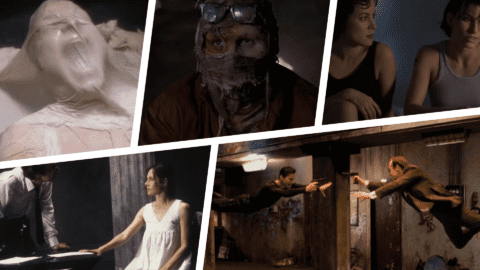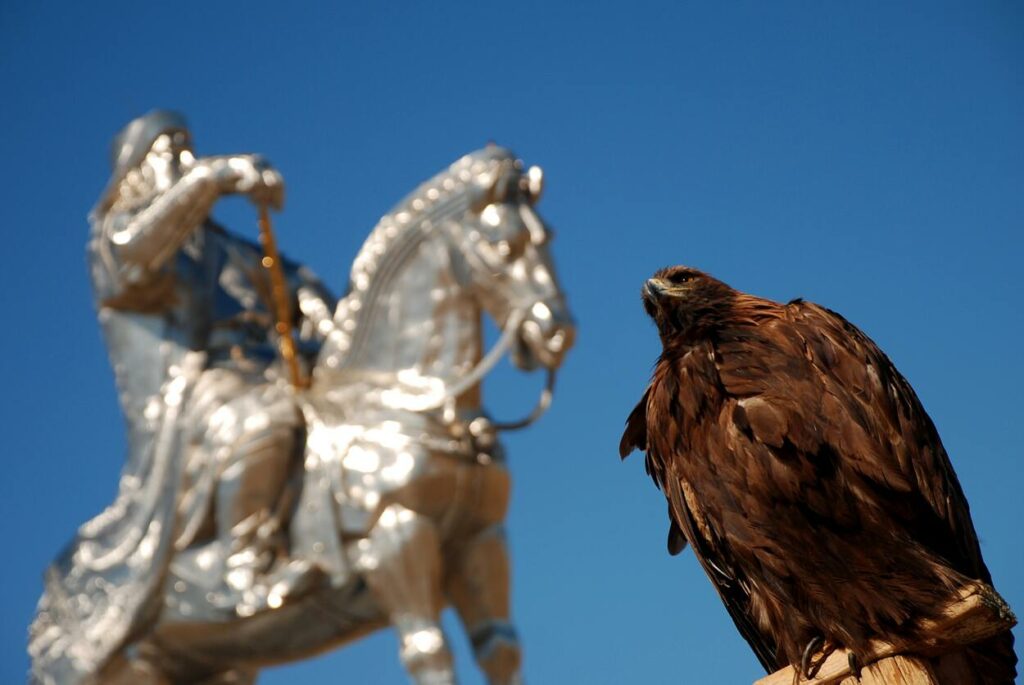This is an article entitled, The Conqueror: How to Make the Worst Movie of All Time by Ryan Uytdewilligen. What follows are Ryan’s words. Enjoy!
The Conqueror was released in 1956 by RKO. The highly expensive old-fashioned epic tells the tale of Mongol warrior Genghis Khan.
While it could have easily faded into obscurity or lived on as a mediocre effort of the era, this particular movie had just about everything wrong going for it.
Starring John Wayne in the titular role – yes, you read that right – The Conqueror has topped list after list when it comes to choosing the worst motion picture ever made.
Here’s the ingredient list of how the most abysmal screen effort came to be.
Step One: The Primadonna Producer
Howard Hughes, on top of being an aviator, lothario, and weapons manufacturer, also produced movies.
While some of his works like Scarface and The Front Page are fondly remembered, his directorial efforts like Hell’s Angels and The Outlaw were bloated and overly expensive messes.
After working in and out of Hollywood, Hughes swooped in with RKO Studios, the makers of classics ranging from King Kong to Citizen Kane, after it went up for sale in 1948.
Hughes began firing anyone he suspected of being a communist and made trashy films all while never setting foot inside the studio.
As his six-year run as the studio’s sole commander and chief, RKO’s legacy and financial stability was driven straight into the ground.
Step Two: The Unenthused Development
After Hughes suddenly demanded a production covering the life and times of Genghis Khan, Academy-Award-nominated screenwriter Oscar Millard was brought in to pen the story – despite knowing absolutely nothing about the subject.
He pumped the script full of Shakespearian language in order to sound fancy while basing the production style after popular biblical epics of the time.
Big stars like Marlon Brando and Yul Brynner immediately turned the project down. Eventually, it was stuffed inside a drawer where it collected dust.
Step Three: The Miscast Star
John Wayne was on top of the world in the early 1950s as the number one box office star.
After starring in hits like Fort Apache, She Wore a Yellow Ribbon, and The Quiet Man, Wayne was yearning to do something different.
Owing three films to RKO amid the studio system days, Wayne starred in the first two right away (Jet Pilot and Flying Leathernecks); but it took years to find the third and final film to complete his obligation.
He apparently found The Conqueror lying in a trash receptacle and suggested they do the film.
Despite being a Caucasian cowboy, Wayne insisted on doing the part and dawned yellowface makeup to play the role.
Step Four: The Ragtag Crew
Song and dance man Dick Powell, who later starred as Phillip Marlow and became one of the first to break into television, signed on as director despite only helming one feature film before.
Susan Hayward, who was battling alcoholism at the time, joined the film as Bortai, the story’s love interest.
A bevy of RKO’s longtime set designers and costume creators worked at rapid speed to bring the Mongol world to life.
But with stars like Agnes Moorehead and Pedro Armendariz on board, there was no way the world would be accurate.
Step Five: The Lethal Location
To double for the Gobi Desert, location scouts were dispatched to the western United States where they came across Snow Canyon, Utah.
Adjacent to the quiet Mormon community of St. George, the crew descended on the town in order to shoot the movie in the summer of 1954.
The problem was that nuclear bombs tests had been conducted at the Nevada Proving Grounds some one-hundred-and-thirty-miles west near Las Vegas.
The booming military site was home to the most bombed grounds on earth where a variety of different tests were being conducted on the regular since opening in 1951.
Wind had apparently blown nuclear fallout to Snow Canyon where it collected and began to mix with the sand, livestock, and drinking water.
Residents explained that they had been encouraged to watch the tests happen and that the Atomic Energy Commission had assured them everything was safe.
Howard Hughes promised everything was fine and lit the green light on production.
Step Six: The Plagued Production
Filming in the desert proved to be a big problem as most days reached well over 100 degrees Fahrenheit.
The water wells for the cast and crew frequently dried up and so people were fainting and being taken to the hospital for heat exhaustion.
There were flash floods and technical problems slowing down the shoot. Hayward sunk deeper into alcoholism while Wayne relied on Dexedrine pills to give him an extra pep in his step.
A panther being used on the set apparently almost took a chunk out of Hayward’s head when it got distracted by her costume while Armendariz fell off his horse and broke his jaw.
After being bombarded by fans and journalists, the exhausted cast and crew left St. George after several months of difficult, dangerous work.
Step Seven: The Money Fire
Hughes was apparently unconvinced by the footage shipped back to him – the producer never once stepped foot on set – he ordered a bevy of reshoots to be done in Culver City.
Hughes ordered sixty tons of sand from the exact same portion of desert in Utah where The Conqueror had just been wrapped filming; sending truck after truck to head out and bring it back to Hollywood so that the sand would match on screen.
If this unnecessary expense wasn’t enough, Hughes dumped millions on advertising and then abruptly left, not only the project, but RKO Studios all-together.
He would sell all his shares in 1955 and leave the motion picture business for good – sinking deeper and deeper into Obsessive Compulsive madness at his hotel suite in Las Vegas.
The new owners found the once glorious company in shambles and struggled to stay afloat, counting on their only major resource, The Conqueror, to keep the doors open.
Step Eight: The Poor Timing
The Conqueror was officially released on March 28th, 1956 after long editing delays and drawn-out advertising campaigns. Critics stuck up their noses, criticizing Wayne’s casting and the historical inaccuracies.
Audiences, meanwhile, flocked to the film – making it the thirteenth highest-grossing movie of the year.
The problem was, other big-budget behemoths like The Ten Commandments and Around the World in 80 Days proved to be far bigger hits.
One of the biggest years for 1950s cinema, John Wayne’s Mongol epic just couldn’t compete.
It failed to recoup its $56 million budget – making it one of the most expensive movies of all time – and faded into obscurity once Howard Hughes made it his mission to buy up all the copies and take it out of circulation.
With no more capital and nothing left to release, RKO Studios was sold to Desi Arnaz and Lucille Ball at the end of the decade to be used for television production.
Step Nine: The Urban Legend
Throughout the 1960s and 1970s, numerous cast and crew members began passing away at young ages due to cancer.
Dick Powell, Susan Hayward, Agnes Moorehead, Pedro Armendariz, and others all died in this time while John Wayne battled lung cancer in 1964 but came out on top.
Though he quit smoking and became an advocate for the American Cancer Society, the cancer would return and claim the icon’s life in 1979.
At that same time, cancerous deaths were on the rise in Utah, Nevada, and areas around the atomic proving grounds.
While senators worked to bring bills to congress to pass out apologies and reparations, it would take a People Magazine article in 1981 profiling The Conqueror’s cancer woes to bring it to the public eye.
By the end of the 1980s, nuclear testing ceased in the United States and The United States Radiation Exposure Compensation Act passed, though no one involved with the film production would be eligible.
Step Ten: The Legacy
While RKO’s legacy was tarnished and mostly forgotten, The Conqueror lived on thanks to the invention of home video.
Curious fans sought the film after it had been hidden from the public until Hughes’ death in 1977.
It was subsequently labeled one of the worst movies of all time and soon became a “so bad it’s good” cult classic. Out of a total of 220 members–91 had contracted cancer by 1981 and 46 out of that 91 had died.
While some have worked to dismiss the urban legend, others have said radiation from nuclear fallout may have certainly played a role.
Either way, the film is still considered one of Hollywood’s biggest blunders, and even Wayne himself later said he regretted the role.
On the contrary, St. George, Utah is one of the United State’s fastest-growing cities. You can recreation at both Snow Canyon and the Nevada Test Site.
So, in order to avoid disaster and even death, the moral of the story is don’t bite off more than you can chew, cast actors who are suited to specific roles, and whatever you do, don’t film on a nuclear test site.
The saga of The Conqueror, including its making of and involvement with nuclear testing and ruining RKO studios, is detailed in the new non-fiction book, Killing John Wayne.
Ready to learn about some other Film Movements or Film History?
-
 anemptytextlline
anemptytextlline -
 anemptytextlline
anemptytextlline -
 anemptytextlline
anemptytextlline -
 anemptytextlline
anemptytextlline -
 anemptytextlline
anemptytextlline -
 anemptytextlline
anemptytextlline -
 anemptytextlline
anemptytextlline -
 anemptytextlline
anemptytextlline -
 anemptytextlline
anemptytextlline -
 anemptytextlline
anemptytextlline -
 anemptytextlline
anemptytextlline -
 anemptytextlline
anemptytextlline













